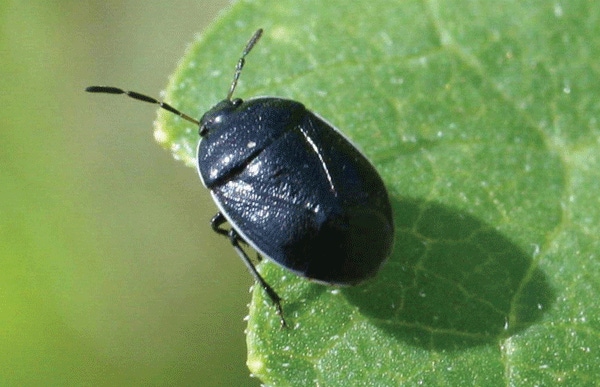
• Peanut quality problems were enhanced this past year by exploding populations of burrower bugs.• It hasn’t been in the picture since 1960, but the burrower has returned with a vengeance.• There are six species of burrower bugs that feed on peanuts, with Pangaeus bilineatus being the most prevalent pest.
May 2, 2011

There will always be quality problems in peanuts to some degree due to the dynamics of the crop itself and changing weather conditions. However, those problems were enhanced this past year by exploding populations of burrower bugs.
“I can remember when the peanut disease cylindrocladium black rot (CBR) was almost non-existent in Georgia. The same can be said of the burrower bug — it existed, but we didn’t know anything about it,” says David Adams, University of Georgia Extension entomologist.
It hasn’t been in the picture since 1960, but it has returned with a vengeance, he says.
There are six species of burrower bugs that feed on peanuts, with Pangaeus bilineatus being the most prevalent pest.
“It looks like a stinkbug, smells like a stinkbug, and acts like a stinkbug, but it’s in a totally different family. It is a distant cousin,” says Adams.
Jay Chapin, retired from Clemson University, researched the burrower bug in 2002, he says. “The primary species we’re concerned with is about the size of a small fingernail. It has strong legs for digging, especially in sandy soils.”
The distribution of the insect is very widespread, says Adams. “One research trial from several years ago showed 30 bugs per row inch, which shows how prolific it can be. The first time I ever saw this insect was in 1975, which was the first year I was out of school. I almost never saw this bug for 30 years.”
In Brooks County this past year, peanut producers had severe problems with the burrower bug, resulting in many loads of Seg. 2 peanuts with damage from the pest. “You could go two counties over, and you didn’t find any Seg. 2 peanuts due to burrower bug damage. It’s highly variable and spotty, but for the guys with Seg. 2 peanuts, it’s a serious problem and it may continue to be a serious problem. We don’t know. Insects tend to be cyclical in nature, so we don’t know what can happen next year,” says Adams.
The mouthparts of the burrower bug are inserted into mature kernels, resulting in light yellow or brown feeding spots or pitting. Damage shows itself as a loss in kernel weight and quality, and an increase in aflatoxin.
Damage hard to detect
“Unless you remove the skin of the peanut seeds, you almost don’t see the damage,” says Adams. “Once graders found it, they started checking more closely. It looks like stinkbug damage on soybeans.”
In general, he says, the first field generation of the pest is in May or June. The second generation is probably in July and August. The third field generation, if it occurs, would be in September or October.
“Most of these bugs have one to two generations per season. With our heat index this past year, we feel like we had at least a partial third generation.”
The bugs can feed through a mature peanut seed wall all the way into the seed, says Adams. They prefer to attack maturing peanuts. “You can sample for these bugs, but we don’t know if that’ll help us in scouting for it,” says Adams.
Burrower bug damage isheavily influenced by strip-till systems, he says. “We had some problems in conventional-till fields, but it’s probably due to the fact we had exploding populations. Drought conditions certainly had an impact on it, more positive just like with a lot of caterpillars. There’s not much for them to feed on in a drought, so they’ll feed on whatever is growing.
“Previous crop residues, such as corn and wheat stubble, and weeds also have an impact.
Peanuts planted strip-till in corn or wheat residue appear to have the most problems with burrower bugs. On the other hand, strip-tilling in a rye residue doesn’t seem to cause as many problems with the pest.”
Most growers, says Adamas, don’t want to go back to a conventional-tillage system. “This is probably why the pest has crept up on us and had such a great impact, because a lot of growers who went to strip-tillage. That’s where we have a real problem. It helps if we till the soil prior to planting a fall or winter cover, if we’re strip-tilling in the spring. Do a good job of harrowing it to disturb the diapausing population.”
Deep turning is the most effective cultural practice for avoiding burrower bug problems, he says.
In-season cultivation reduces the population of the pest, says Adams, and late-season migration of adults is less likely to result in significant immature populations.
“If you strip-till, it comes out and lays its eggs, and there are two to three generations in the field. If you disturb the soil and destroy the diapausing population before you plant, any damage probably will be from a migrating population when the pods are maturing in August or September. You only have one field generation.”
Drought conditions favor the intensity of the bug, he says, so irrigation or adequate rainfall helps to reduce potential damage. “Even with strip-till, we tend to have less of a problem in irrigated situations. Soil insecticides will suppress them, but we can’t get it to the target most of the time. If we get good rainfall, especially summer rain, hopefully we can reduce the potential of this pest.”
In Alabama this past year, outbreaks of burrower bugs causing damage to peanuts were seen in Baldwin, Escambia and Monroe counties.
To get an idea on just how much damage the bug can do, see http://southeastfarmpress.com/peanuts/burrower-bugs-hit-record-levels-georgia-peanut-crop.
About the Author(s)
You May Also Like



